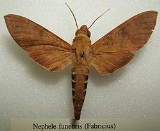
Nephele funebris
Encyclopedia
Nephele funebris is a moth
of the Sphingidae
family. It is very common throughout most of the Ethiopian Region, excluding Madagascar
and the Congo-Cameroon
equatorial forest belt, where it is replaced by Nephele maculosa
.
The length of the forewings is 33-39 mm. It is very similar to Nephele comma
, but less variable in colour. Usually it is some shade of dark olive brown. It can be separated from N. comma by the presence of five large blackish lateral spots on the abdomen and by the much more irregular margin of the terminal area of the forewings, which does not contrast in colour with the remainder of the wing. The typical form has no stigma, or at most a minute whitish dot. Form conimacula has a silvery white stigma in the shape of a longitudinal wedge-shaped spot, sometimes surmounted proximally by a much smaller elongated spot.
The larvae have a red-brown head and body. The body is minutely streaked with black. The pupa is made in a slight web among litter on the surface of the soil. It is reddish chestnut in colour.
Moth
A moth is an insect closely related to the butterfly, both being of the order Lepidoptera. Moths form the majority of this order; there are thought to be 150,000 to 250,000 different species of moth , with thousands of species yet to be described...
of the Sphingidae
Sphingidae
Sphingidae is a family of moths , commonly known as hawk moths, sphinx moths and hornworms, that includes about 1,200 species . It is best represented in the tropics but there are species in every region . They are moderate to large in size and are distinguished among moths for their rapid,...
family. It is very common throughout most of the Ethiopian Region, excluding Madagascar
Madagascar
The Republic of Madagascar is an island country located in the Indian Ocean off the southeastern coast of Africa...
and the Congo-Cameroon
equatorial forest belt, where it is replaced by Nephele maculosa
Nephele maculosa
Nephele maculosa is a moth of the Sphingidae family. It is only known from the Congo-Cameroon equatorial forest belt.It is a very similar to Nephele funebris, but larger and more variegated....
.
The length of the forewings is 33-39 mm. It is very similar to Nephele comma
Nephele comma
Nephele comma is a moth of the Sphingidae family. It is very common throughout the Ethiopian Region, including Madagascar.The length of the forewings is 32-39 mm and the wingspan is 76-86 mm. It is a very variable species. The body and forewings are dark olive green to reddish-brown and to light...
, but less variable in colour. Usually it is some shade of dark olive brown. It can be separated from N. comma by the presence of five large blackish lateral spots on the abdomen and by the much more irregular margin of the terminal area of the forewings, which does not contrast in colour with the remainder of the wing. The typical form has no stigma, or at most a minute whitish dot. Form conimacula has a silvery white stigma in the shape of a longitudinal wedge-shaped spot, sometimes surmounted proximally by a much smaller elongated spot.
The larvae have a red-brown head and body. The body is minutely streaked with black. The pupa is made in a slight web among litter on the surface of the soil. It is reddish chestnut in colour.

